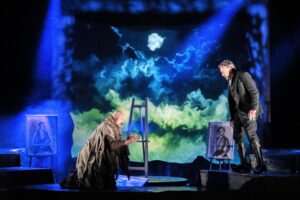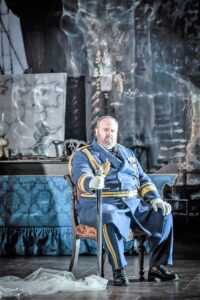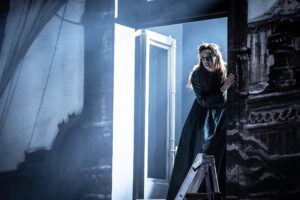The circle is slowly closing. April marked nine years since the Warsaw premiere of Lohengrin in a co-production with Welsh National Opera, a staging that brought me – through a complicated coincidence – to Longborough for a performance of Tristan the following year. Since I found my Wagnerian Promised Land there, every June has been associated with a new production conducted by Anthony Negus. This year LFO staged Götterdämmerung, before the presentation of all parts of the tetralogy, originally planned for this season, but delayed by the pandemic. Next season the Bühnenfestspiel will take place three times, directed by Amy Lane, who still has not managed to show us her complete concept. She prepared Die Walküre in 2021 in a semi-staged version, fortunately available for some time on the OperaVision platform – to wipe away the tears of overseas music lovers and critics, unable to travel to the UK.
When the borders did finally open, I began visiting the British Isles with even greater intensity than before the pandemic. Last season I wrote about a production of The Flying Dutchman by Grange Park Opera, one of the youngest and most ambitious “countryside opera” companies in England. That experience was linked to Longborough through the person of Negus, who confirmed his class as an outstanding interpreter of Wagner’s legacy, leading an ensemble unfamiliar with his baton with a truly stellar cast of solo voices. This time I got the opportunity to make a completely different comparison. The Longborough Götterdämmerung and the new staging of Tristan in Grange Park featured both Isoldes discovered by Negus: Lee Bisset, who sang Brunhilde in LFO’s latest Ring, and Rachel Nicholls, whose 2015 debut in Tristan proved to be a prelude to an international career in the Wagnerian and Straussian repertoire. Two excellent singers representing a distinct, specifically British Wagnerian singing tradition. Two operas about the end of the world or, depending on the interpretation, a hope of building this world completely from scratch. Two stories of transfiguration through love. Two productions the final form of which was largely influenced by the personality of these two artists.
In Longborough the stage is tiny, the orchestra pit is really deep and contact with the audience is extremely intimate. This was one of the reasons why I got the best impressions at LFO from performances presented in a space almost devoid of props, masterfully painted with light by Ben Ormerod, who, following the example of Alphonse Appia, proclaims the primacy of the author and the drama, synchronising the intensity and colours of light with the plot and musical narrative of the work. Amy Lane is a very insightful director, revealing layers of meaning in the Ring that are inaccessible to most contemporary directors of the tetralogy. Unfortunately, her sensitivity is not always matched by the ideas of the other participants in the theatrical concept. Lane’s apposite interpretive cues were not fully reflected in either Rhiannon Newman Brown’s sets – fortunately less overloaded than in last year’s Siegfried – or in the not very inspired lighting direction (Charlie Morgan Jones), or Tim Baxter’s overly literal projections. The director managed to achieve the best understanding with the costume designer (Emma Ryott), who correctly read the intention of universalising the myth, combining the traditional ideas of the appearance of eternal beings (the Norns) with the slightly more contemporary dress – though still not placed in any specific context – of the other dramatis personae.
Götterdämmerung, LFO. Freddie Tong (Alberich) and Julian Close (Hunding). Photo: Matthew Williams-Ellis
There are several memorable and harrowing tropes in Amy Lane’s concept, from the idea to have the thread woven by the Norns bring to mind associations with both the earthly umbilical cord and the roots of the sacred ash tree, chopped down at Wotan’s command before the expected “twilight of the gods”, to the extraordinary scene of Hunding’s Dream, which in Lane’s rendition took the form of a Freudian showdown between the father and the son. Most of Lane’s directorial decisions found their justification in the work and were appropriately reflected in the concept followed by Negus, who, as usual, made sure that there would be logic in the musical dramaturgy and that the narrative pulse would remain brisk without becoming lofty – this was evidence by, for example, Siegfried’s Funeral March, in which the procession did not drag, and the sounds of the orchestra rose like the waves of an angry Rhine or shot sparks from the flames of the funeral pyre and the upcoming conflagration of Valhalla. Negus has an uncanny ability to tell stories with music and engage the listener’s attention to the point of hypnosis. Nevertheless, the level of attention to every detail of the texture, to even the smallest elements of the sound of the various orchestral groups, to every syllable and phrase of the sung text – in Götterdämmerung it exceeded anything we had dealt with in previous parts of the Ring.
The same goes for the vocal side of the performance. Bradley Daley was more convincing than in last year’s Siegfried. His indefatigable, a bit rough, but superbly controlled tenor gained powerful expression in the dying monologue in which the singer gave the audience a sense of who Siegfried would have become, if fate had allowed him to mature enough to become a worthy partner for Brunhilde. For most of the drama the phenomenal Julian Close reigned supreme on stage as Hunding – superb as an actor, but building his character equally with purely musical means. An ominous majesty hides in Close’s voice, black as new moon night, yet seductively beautiful, derived from the best tradition of powerful and dark German basses of the Gottlob Frick variety. Similar power was missing in Freddie Tong’s singing, but the conductor and the director turned this to his advantage in the poignant Hunding’s Dream scene, skilfully contrasting Alberich’s humiliation with the storm of conflicting feelings tormenting his son. Plenty of passion was infused into Waltraute’s short part by the ever reliable Catherine Carby, the memorable Brangäne from the 2015 Tristan. A superb pair of the naïve Gibichungs was created by Laure Meloy (Gutrune), a singer with a round soprano and very secure intonation, and Benedict Nelson (Gunther), who is blessed with a lovely, intelligently used baritone and great dramatic instinct, thanks to which he was able to create a multi-dimensional character, full genuine shame and contempt for his own weakness in the finale. A separate word of praise should go to the two finely tuned ensembles – the Norns (Mae Heydorn, Harriet Williams and Katie Lowe) and the Rhinemaidens (Mari Wyn Williams, Rebecca Afonwy-Jones and Katie Stevenson) – as well as the Festival Chorus, reinforced by members of Longborough’s Community Chorus.
Götterdämmerung, LFO. Lee Bisset (Brunhilde) and Bradley Daley (Siegfried). Photo: Matthew Williams-Ellis
I left the great role of Brunhilde performed by Lee Bisset for last. This splendid actress and, in my opinion, still underappreciated singer should appear on stage more often, if only to make critics realise that the too wide vibrato and squeezed high notes – which the critics like to point out to her sometimes – are not the result of voice fatigue, but the opposite: of not singing enough. I realized already back in December in Inverness that the minor technical shortcomings in her singing were slowly becoming a thing of the past, revealing the incredible beauty of her dark yet surprisingly warm soprano. In Götterdämmerung under Negus’ baton Bisset’s vocal potential went hand in hand with interpretive wisdom. With each line her Brunhilde became – in an almost palpable way – more and more aware of the role assigned to her by fate in the inevitable end of the old world order. She reached the fullness of this enlightenment in her final monologue. Most contemporary Wagnerian sopranos put all their strength into merely singing this powerful scene. Bisset was able to make it varied: with gestures, facial expressions, a whole palette of voice colours, speaking to the Gibichungs in one tone, accusing Wotan in another, using a different one still to delve into the meaning and cause of Siegfried’s death, and finally becoming united with him in the ecstatic words “Selig grüsst dich dein Weib”. In such an interpretation Brunhilde’s transfiguration appeals much more strongly to the imagination than any transfiguration of Isolde – especially when complemented by such a painterly interpretation of the annihilation of the Ring and the ruin of Valhalla. No wonder, therefore, that after the last chord in the orchestra died down, complete silence fell in the auditorium, broken only after a minute by an outburst of frenetic applause. After such twilight, dawn does not come soon.
This was not, in any case, the first such experience in Longborough. I don’t think I will live to see another Tristan on a par with the premiere and the subsequent revival at LFO two years later – conducted by Negus and directed by Carmen Jakobi. I have not given up hope yet: every season I try to see and hear at least two new productions of this opera. And I must admit that this year’s Tristan at Grange Park Opera turned out to be one of the best in musical terms.
I can’t say the same about the theatrical side of things, despite the fact that Charles Edwards is a very versatile artist and has an impressive number of opera productions to his credit – mainly as set designer, but also as lighting director and creator of original productions in which he was responsible for the whole staging concept. Frankly speaking, I would have trouble pointing out characteristic elements of his style, which is in constant flux – largely dependent, I think, on the current demand for specific aesthetics and interpretive themes. I admired his superb set design for Katia Kabanova directed by David Alden in Warsaw; I wrote warmly about the coherent visual concept of the Little Greats cycle at Opera North, where Edwards also directed I Pagliacci; my hair stood on end when I saw how he littered the stage in the bizarre production of Gounod’s Faust at Poznań’s Teatr Wielki, a production directed by Karolina Sofulak. In his Tristan for Grange Park Opera, he followed the fashionable biographical trope, suggesting – rightly, to some extent – that Wagner composed the opera in the throes of passion for Mathilde von Wesendonck, forgetting, however, that the composer had come up with the idea several years earlier and under the influence not of his affection for the silk merchant’s beautiful wife, but of reading Schopenhauer. Edwards cluttered the stage almost as much as in Poznań, styling it neither as the interior of the Wesendoncks’ Zurich villa, nor as the chambers of the fairytale castle of Neuschweinstein, and closing it with sets that, contrary to the pre-premiere hype and misleading announcements, did not draw on the first performance of Tristan, but on later productions in Bayreuth, the first of which was presented three years after Wagner’s death. It was for this production, directed by Cosima herself, that Max Brückner designed the sets. But Edwards did not stop there: in Act III he used Kurt Söhnlein’s design for Siegfried Wagner’s famous 1927 staging.
Tristan und Isolde, GPO. Gwyn Hughes Jones (Tristan). Photo: Marc Brenner
This is what may happen when the director doesn’t commission thorough research before getting down to work. Instead of a bold reinterpretation we got a cliché replicating common myths about the circumstances of the work’s creation and its Munich premiere. Edwards entrusted the lighting direction to Tim Mitchell, who bathed this panopticon in colours that brought to mind a B grade horror film rather than the story of two lovers joined in death. The situation was remedied a bit by Gabrielle Dalton’s stylish costumes, but we still got a story of common marital infidelity instead of symbolism and metaphysics. In addition, the finale was dangerously reminiscent of the ending of Katharina Thoma’s Frankfurt staging three years ago, where Isolde’s love’s transfiguration, like in Edwards’ interpretation, took place without Tristan, sent backstage before that.
Tristan was rescued by Wagner himself or, more precisely, by his music – in an above-average, at times even thrilling performance. Stephen Barlow conducted, confidently and elegantly, though approaching the Wagnerian matter quite differently from Negus, who builds up the dramaturgy in Tristan by alternating tensions and relaxations. In Barlow’s interpretation the musical narrative follows an ascending curve slowly but inexorably, especially in the overall agogic plan. At first I found this boring then began to appreciate it, especially since the Gascoigne Orchestra played under Barlow’s baton with precision, a beautifully balanced sound and an excellent sense of the proportion between the pit and the stage.
The Welsh tenor Gwyn Hughes Jones, who had been primarily associated with Italian repertoire over the years, made his debut as Tristan in Grange Park. Jones has a soft voice with a beautiful, golden tone, excellent technique and a valuable ability to pace himself throughout the performance. His melancholic, endearingly lyrical Tristan may not have appealed to the advocates, so numerous today, of casting stentorian Heldentenors in the role, but I think he would have won praise from Wagner himself, who valued intelligence and a sense of musical drama in singers above all. Both qualities were not lacking in Jones’ performance in the great monologue of Act III, from the first bars shrouded in the darkness of the longed-for night of death. Keeping vigil over the wounded hero was one of the finest Kurwenals I had heard in recent seasons – David Stout, who with such sensitivity and with such a well-controlled baritone, perfectly developed in the lower register, could soon begin to consider making a debut in any of the heavier Wagnerian roles. That was not the end of the revelations, however. Matthew Rose provided me with yet another argument to substantiate the thesis that in the finale of Act II of Tristan Wagner came the closest to the heart of ancient tragedy. King Marke’s monologue, phenomenally interpreted by Rose, contained neither fury nor shame: only a calm, bitter statement of a fact that can no longer be reversed. I think that the English bass deliberately added a bit of a Verdian hue to his singing: I was not the only one who began to wonder about a possible affinity between Don Carlos and Tristan, premiered a few years before Verdi’s opera. Brangäne found an equally outstanding interpreter in the person of Christine Rice, one of the finest mezzo-sopranos of her generation as well as an excellent actress. Very decent performances in minor roles came from Sam Utley (Shepherd) and Thomas Isherwood (Steersman). Mark Le Brocq deserves separate praise for his take on the role in which Edwards merged the characters of Melot and Young Sailor into one. A silly idea, but splendid performance: especially memorable for me was the sneer heard in the sailor’s song “Irische Maid, du wilde, minnige Maid”, fully justifying Isolde’s later outburst of rage.
Tristan und Isolde, GPO. Rachel Nicholls (Isolde). Photo: Marc Brenner
Isolde was portrayed, once again in her career, by Rachel Nicholls, an extremely musical singer with an exuberant stage temperament and expressive personality. Her voice is as full as Bisset’s, but sharper, more girlish, sparkling with different colours. There is more frustration and rebellion in her anger, and more impulsive passion than calm, intimate closeness in her displays of feeling. In Edwards’ staging she had to play the role of an unfulfilled bourgeois woman who did not appreciate the potential of her femininity until the final transfiguration. Nicholls correctly read this cue as a turn towards modernism, including musical modernism. She imbued her interpretation with her recent experience in the Straussian repertoire, building a character at times more human than Tristan, or in any case better understood by a contemporary audience. She created a memorable Isolde, also, I think, thanks to her own efforts, because I saw in her singing and acting many gestures remembered from earlier productions.
And we are complaining about the twilight of Wagnerian idols. Perhaps it’s time to set fire to this rotten Valhalla and start everything all over again?
Translated by: Anna Kijak




